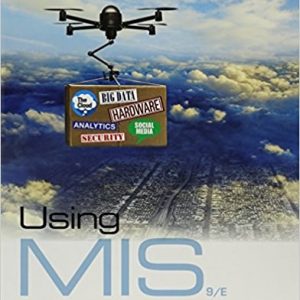Instructor Manual For Designing and Managing the Supply Chain 3e by David Simchi-Levi, Philip Kaminsky, Edith Simchi-Levi

Product details:
- ISBN-10 : 0073341525
- ISBN-13 : 978-0073341521
- Author: Simchi–Levi, David, Kaminsky, Philip, Simchi–Levi, Edith
Designing and Managing the Supply Chain, 3/e provides state-of-the-art models, concepts, and solution methods that are important for the design, control, operation, and management of supply chain systems. In particular, the authors attempt to convey the intuition behind many key supply chain concepts and to provide simple techniques that can be used to analyze various aspects of the supply chain. Topical coverage reflects the authors’ desire to introduce students to those aspects of supply chain management that are critical to the success of a business. Although many essential supply chain management issues are interrelated, the authors strive to make each chapter as self-contained as possible, so that the reader can refer directly to chapters covering topics of interest. Each chapter utilizes numerous case studies and examples, and mathematical and technical sections can be skipped without loss of continuity. The 3rd edition represents a substantial revision.
Table contents:
1. INTRODUCTION TO SUPPLY CHAIN MANAGEMENT 1 1.1 What Is Supply Chain Management? 1 1.2 Global Optimization 3 1.3 Managing Uncertainty 4 1.4 Why Supply Chain Management? 5 1.5 Key Issues in Supply Chain Management 8 1.6 Book Objectives and Overview 12 Discussion Questions 13 CASE: Meditech Surgical 14 2. LOGISTICS NETWORK CONFIGURATION 23 CASE: The Bis Corporation 23 2.1 Introduction 24 2.2 Data Collection 25 2.2.1 Data Aggregation 27 2.2.2 Transportation Rates 30 2.2.3 Mileage Estimation 31 2.2.4 Warehouse Costs 32 2.2.5 Warehouse Capacities 33 2.2.6 Potential Warehouse Locations 34 2.2.7 Service Level Requirements 34 2.2.8 Future Demand 34 2.3 Model and Data Validation 35 2.4 Solution Techniques 35 2.4.1 Heuristics and the Need for Exact Algorithms 36 2.4.2 Simulation Models and Optimization Techniques 38 2.5 Key Features of a Network Configuration DSS 39 2.6 Solving the Bis Corporation Distribution Problem 40 Summary 40 Discussion Questions 41 3. INVENTORY MANAGEMENT AND RISK POOLING 43 CASE: JAM Electronics: Service Level Crisis 43 3.1 Introduction 44 3.2 A Single Warehouse Inventory Example 46 3.2.1 The Economic Lot Size Model 47 3.2.2 The Effect of Demand Uncertainty 49 CASE: Swimsuit Production 49 3.2.3 Supply Contracts 53 3.2.4 Multiple Order Opportunities 58 3.2.5 Continuous Review Policy 58 3.2.6 Variable Lead Times 62 3.2.7 Periodic Review Policy 62 3.3 Risk Pooling 64 CASE: Risk Pooling 64 3.4 Centralized versus Decentralized Systems 66 3.5 Managing Inventory in the Supply Chain 67 3.6 Practical Issues 69 3.7 Forecasting 70 3.7.1 Judgment Methods 71 3.7.2 Market Research Methods 71 3.7.3 Time-Series Methods 71 3.7.4 Causal Methods 72 3.7.5 Selecting the Appropriate Forecasting Technique 72 Summary 73 Discussion Questions 73 CASE: Sport Obermeyer 76 4. THE VALUE OF INFORMATION 91 CASE: Barilla SpA (A) 91 4.1 Introduction 101 4.2 The Bullwhip Effect 101 4.2.1 Quantifying the Bullwhip Effect 104 4.2.2 The Impact of Centralized Information on the Bullwhip Effect 106 4.2.3 Methods for Coping with the Bullwhip Effect 109 4.3 Effective Forecasts 110 4.4 Information for the Coordination of Systems 111 4.5 Locating Desired Products 112 4.6 Lead-Time Reduction 112 4.7 Information and Supply Chain Trade-offs 112 4.7.1 Conflicting Objectives in the Supply Chain 113 4.7.2 Designing the Supply Chain for Conflicting Goals 113 Summary 116 Discussion Questions 117 5. SUPPLY CHAIN INTEGRATION 119 CASE: Modern Book Distribution, Inc. 119 5.1 Introduction 120 5.2 Push, Pull, and Push?Pull Systems 121 5.2.1 Push-Based Supply Chain 121 5.2.2 Pull-Based Supply Chain 121 5.2.3 Push?Pull Supply Chain 122 5.2.4 Identifying the Appropriate Supply Chain Strategy 123 5.2.5 Implementing a Push?Pull Strategy 125 5.3 Demand-Driven Strategies 127 5.4 The Impact of the Internet on Supply Chain Strategies 128 5.4.1 What Is E-Business? 130 5.4.2 The Grocery Industry 131 5.4.3 The Book Industry 131 5.4.4 The Retail Industry 132 5.4.5 Impact on Transportation and Fulfillment 132 5.5 Distribution Strategies 133 5.5.1 Direct Shipment 134 5.5.2 Cross-Docking 134 5.5.3 Transshipment 136 5.6 Centralized versus Decentralized Control 136 5.7 Central versus Local Facilities 137 Summary 138 Discussion Questions 138 CASE: The Great Inventory Correction 139 6. STRATEGIC ALLIANCES 143 CASE: How Kimberly-Clark Keeps Client Costco in Diapers 143 6.1 Introduction 146 6.2 A Framework For Strategic Alliances 147 6.3 Third-Party Logistics 149 6.3.1 What Is 3PL? 149 6.3.2 Advantages and Disadvantages of 3PL 149 6.3.3 3PL Issues and Requirements 152 6.3.4 3PL Implementation Issues 152 6.4 Retailer?Supplier Partnerships 153 6.4.1 Types of RSP 153 6.4.2 Requirements for RSP 154 6.4.3 Inventory Ownership in RSP 155 6.4.4 Issues in RSP Implementation 156 6.4.5 Steps in RSP Implementation 157 6.4.6 Advantages and Disadvantages of RSP 157 6.4.7 Successes and Failures 159 6.5 Distributor Integration 160 6.5.1 Types of Distributor Integration 160 6.5.2 Issues in Distributor Integration 161 Summary 162 Discussion Questions 162 CASE: Audio Duplication Services, Inc. (ADS) 163 7. PROCUREMENT AND OUTSOURCING STRATEGIES 165 CASE: FreeMarkets OnLine, Inc. 165 7.1 Introduction 178 7.2 Outsourcing Benefits and Risks 180 7.3 A Framework for Buy/Make Decisions 182 7.4 E-Procurement 183 7.5 A Framework for E-Procurement 187 Summary 190 Discussion Questions 190 8. INTERNATIONAL ISSUES IN SUPPLY CHAIN MANAGEMENT 191 CASE: Wal-Mart Changes Tactics to Meet International Tastes 191 8.1 Introduction 194 8.1.1 Global Market Forces 195 8.1.2 Technological Forces 196 8.1.3 Global Cost Forces 196 8.1.4 Political and Economic Forces 196 8.2 Risks and Advantages of International Supply Chains 197 8.2.1 Risks 197 8.2.2 Addressing Global Risks 198 8.2.3 Requirements for Global Strategy Implementation 199 8.3 Issues in International Supply Chain Management 200 8.3.1 International versus Regional Products 201 8.3.2 Local Autonomy versus Central Control 201 8.3.3 Miscellaneous Dangers 202 8.4 Regional Differences in Logistics 203 8.4.1 Cultural Differences 203 8.4.2 Infrastructure 204 8.4.3 Performance Expectation and Evaluation 204 8.4.4 Information System Availability 205 8.4.5 Human Resources 205 Summary 206 Discussion Questions 206 9. COORDINATED PRODUCT AND SUPPLY CHAIN DESIGN 207 CASE: Hewlett-Packard: DeskJet Printer Supply Chain 207 9.1 Design for Logistics 214 9.1.1 Overview 214 9.1.2 Economic Packaging and Transportation 215 9.1.3 Concurrent and Parallel Processing 216 9.1.4 Standardization 217 9.1.5 Selecting a Standardization Strategy 221 9.1.6 Important Considerations 221 9.1.7 The Push?Pull Boundary 222 9.1.8 Case Analysis 223 9.2 Supplier Integration into New Product Development 225 9.2.1 The Spectrum of Supplier Integration 225 9.2.2 Keys to Effective Supplier Integration 226 9.2.3 A ?Bookshelf? of Technologies and Suppliers 226 9.3 Mass Customization 227 9.3.1 What Is Mass Customization? 227 9.3.2 Making Mass Customization Work 227 9.3.3 Mass Customization and Supply Chain Management 228 Summary 229 Discussion Questions 230 CASE: Hewlett-Packard Company: Network Printer Design for Universality 230 10. CUSTOMER VALUE AND SUPPLY CHAIN MANAGEMENT 237 CASE: Dell?s Direct Business Model 237 10.1 Introduction 238 10.2 The Dimensions of Customer Value 240 10.2.1 Conformance to Requirements 240 10.2.2 Product Selection 242 10.2.3 Price and Brand 244 10.2.4 Value-Added Services 245 10.2.5 Relationships and Experiences 246 10.3 Strategic Pricing 248 10.3.1 Revenue Management 249 CASE: Hotel Rooms 249 10.3.2 Smart Pricing 251 10.4 Customer Value Measures 253 10.5 Information Technology and Customer Value 256 Summary 258 Discussion Questions 259 11. INFORMATION TECHNOLOGY FOR SUPPLY CHAIN MANAGEMENT 261 CASE: Backup in the Espresso Lane 261 CASE: ERP Brews Instant Success 264 11.1 Introduction 266 11.2 Goals of Supply Chain Information Technology 267 11.3 Standardization 271 11.4 Information Technology Infrastructure 274 11.4.1 Interface Devices 274 11.4.2 Communications 275 11.4.3 Databases 276 11.4.4 System Architecture 277 11.4.5 Electronic Commerce 279 11.4.6 Electronic Commerce Levels 280 11.5 Supply Chain Management System Components 283 11.6 Integrating Supply Chain Information Technology 286 11.6.1 Stages of Development 287 11.6.2 Implementation of ERP and DSS 288 11.6.3 ?Best-of-Breed? versus Single-Vendor ERP Solutions 290 Summary 291 Discussion Questions 292 12. DECISION-SUPPORT SYSTEMS FOR SUPPLY CHAIN MANAGEMENT 293 CASE: Supply Chain Management Smooths Production Flow 293 12.1 Introduction 294 12.2 The Challenges of Modeling 296 12.3 Structure of Decision-Support Systems 297 12.3.1 Input Data 298 12.3.2 Analytical Tools 300 12.3.3 Presentation Tools 303 12.4 Supply Chain Decision-Support Systems 307 12.5 Selecting a Supply Chain DSS 315 Summary 317 Discussion Questions 318 Appendix A Computerized Beer Game 319 A.1 Introduction 319 A.2 The Traditional Beer Game 319 A.2.1 The Difficulties with the Traditional Beer Game 320 A.3 The Scenarios 321 A.4 Playing a Round 322 A.4.1 Introducing the Game 322 A.4.2 Understanding the Screen 323 A.4.3 Playing the Game 324 A.4.4 Other Features 326 A.5 Options and Settings 327 A.5.1 File Commands 327 A.5.2 Options Commands 327 A.5.3 The Play Commands 330 A.5.4 The Graphs Commands 331 A.5.5 The Reports Commands 332 Appendix B The Risk Pool Game 334 B.1 Introduction 334 B.2 The Scenarios 334 B.3 Playing Several Rounds 335 B.3.1 Introducing the Game 335 B.3.2 Understanding the Screen 336 B.3.3 Playing the Game 337 B.3.4 Other Features 337 CONTENTS xxvii B.4 Options and Settings 337 B.4.1 File Commands 338 B.4.2 Play Commands 338 B.4.3 The Reports Commands 340 Appendix C The Inventory Spreadsheet 342 C.1 Introduction 342 C.2 The Spreadsheet 342 Bibliography 343 Index 349 People also search: designing and managing the supply chain 3rd edition designing and managing the supply chain 3rd edition pdf designing and managing the supply chain 3rd edition free download designing and managing the supply chain 3rd edition solutions 3 main functions of supply chain management what are the three flows of supply chain management
|
3 types of supply chain management |





